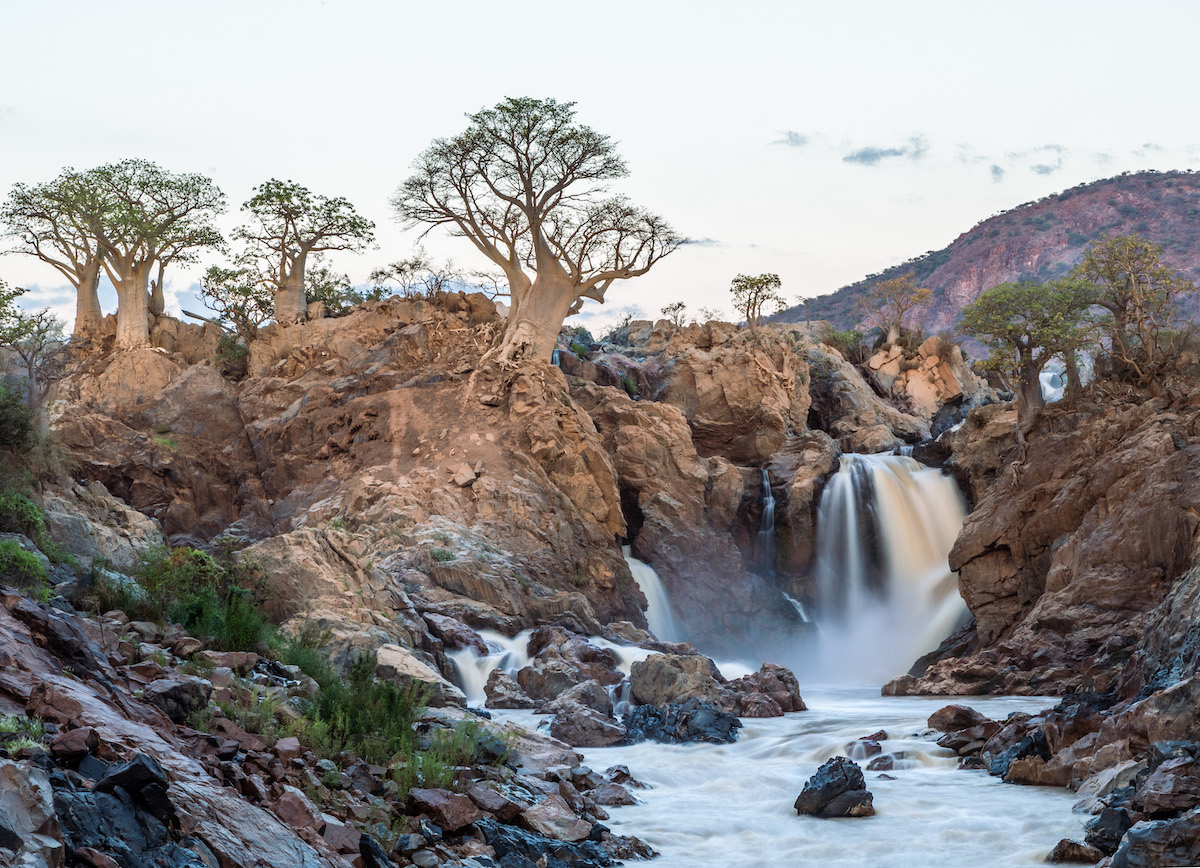
The far-flung northwest
Kaokoland extends from the Kunene River southwards across a sparsely populated and harsh environment down to the Hoanib River. The area holds a special allure for lovers of remote and wild places to negotiate its challenging and rugged terrain in four-wheel- drive vehicles. Attractions include the desert-adapted elephants, scattered Himba settlements, the impressive Epupa Falls, off the beaten track destinations such as the expansive Marienfluss and Hartmann valleys, the wild and beautiful Khowarib Schlucht, and Swartbooisdrift, site of a Dorslandtrekker monument.
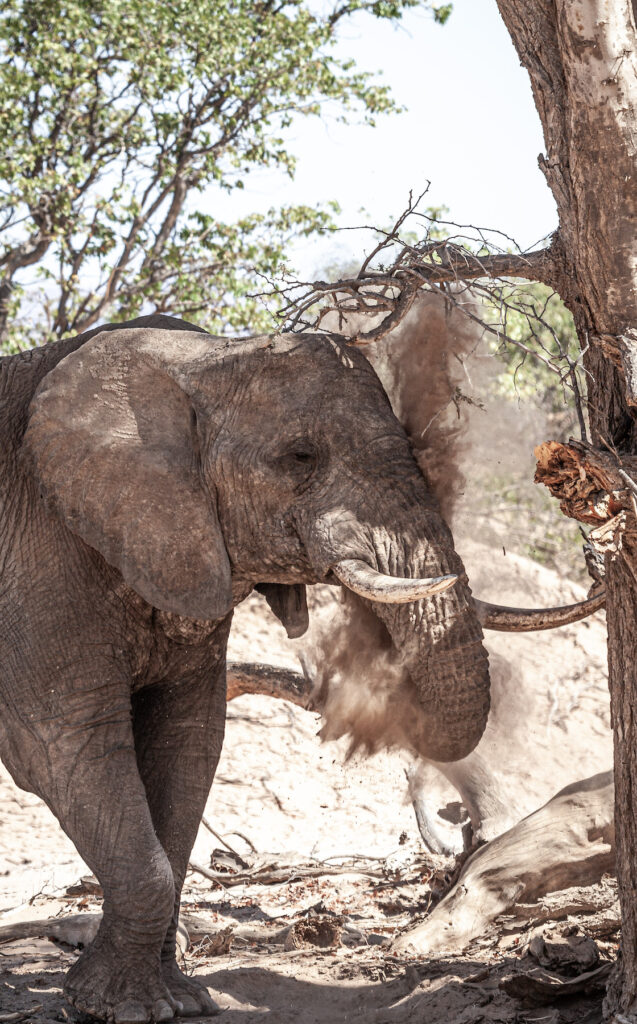
THE FAMOUS DESERT ELEPHANTS
The African elephant, a strong and majestic giant, is a key feature on the plains, in the forest and across other landscapes in Africa. In remote parts of north-western Namibia these gentle giants have adapted to survive in harsh desert conditions. In Kaokoland the desert-adapted elephant’s home ranges cover as much as 3 000 km2, with the animals trekking up to 200 km in search of water. It was thought initially that these elephants were a different species to the African elephant, Loxodonta africana, because they have longer legs, are taller and have larger feet. However, because they have less to eat than their Etosha counterparts, they don’t carry the same body mass, and therefore appear to be taller and have longer legs. But they do have larger feet, an environmental adaptation caused by walking primarily on soft sand all their lives.
Kaokoland’s desert-adapted elephants rotate the home ranges that they occupy as the seasons change to where food and water can be found. Herds are led by a matriarch, who is usually the oldest female and has accumulated as much as 30 years’ experience of the climatic conditions in her home range. By definition,desert-dwelling elephants occupy an arid habitat for at least part of the year and have special behavioural characteristics, large annual and seasonal ranges, and a social structure and daily activities suited to an arid environment. When feeding, these denizens of the desert take far greater care than their relatives in Etosha. They hardly ever fell trees, break fewer branches and debark much less than other elephants. Whereas adult elephants on average drink between 100–200 litres of water a day, in Kaokoland they drink only once every three or four days. During droughts they dig deep, narrow holes (gorras) in dry riverbeds with their tusks, trunk and feet to find water.
In remote parts of north-western Namibia elephants have adapted to survive in harsh desert conditions.
THE DESERT LIONS’ FIGHT FOR SURVIVAL
Another curiosity of the area is the remarkable desert-adapted lion.
With approximately 140 of their kind left, the desert lions are a rare group of carnivores that have adapted to survive in one of the harshest, most unforgiving landscapes on earth. With their numbers dwindling as poaching and human encroachment threaten their future, sightings are few and far between. For more information on the desert lions of the Namib visit www.desertlion.info.
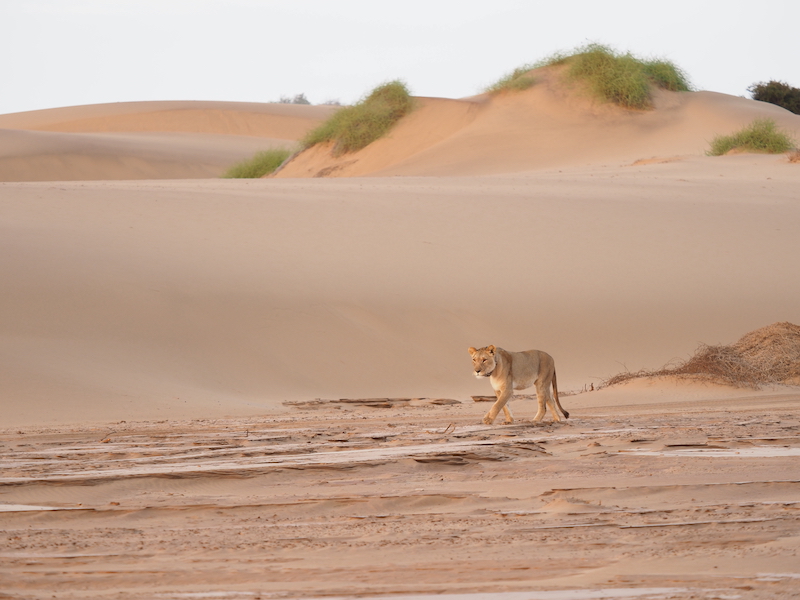
Desert-adapted lioness ©Gerhard Thirion
EPUPA FALLS
With its scenically beautiful surroundings, Epupa is one of Namibia’s prime tourist destinations. The falls are a series of cascades where the Kunene River drops a total of 60 metres over a distance of about 1.5 km, separating into a multitude of channels and forming a myriad of rock pools. Enhanced by richly coloured rock walls, a variety of trees including wild figs, baobabs and waving makalani palms, spectacular sunsets and perennially flowing waters, the Epupa area offers much to see, do and experience.
Bird-watching is rewarding, especially for the rare Rufous-tailed Palm Thrush. Also seen are Bee-eaters, African Fish Eagles, Kingfishers ranging from the Giant to the tiny Malachite Kingfisher, Rosy-faced Lovebirds, Paradise Flycatchers, Turacos, Bulbuls, Hornbills and Rollers.
Scattered settlements of Himba are an especially interesting feature of the area.
Although officially declared as a town only at the end of 2000, Opuwo has long acted as the capital of the Kunene Region, and as the gateway to Epupa Falls and the land of the Himba people. The town itself doesn’t offer much for the tourist, except in the form of hand-made jewellery and other crafts, which can be found at street stalls and at the open market. The Kunene Craft Centre is also a good place to stock up on souvenirs from the area. Opuwo has well-stocked grocery shops, Internet cafés, a post office, banks, fuel stations, a hospital, and everything else a traveller might need.
Opuwo is connected to Kamanjab and Windhoek by a tarred road that is in excellent condition. There’s an airfield in town, managed by the Opuwo Country Hotel.
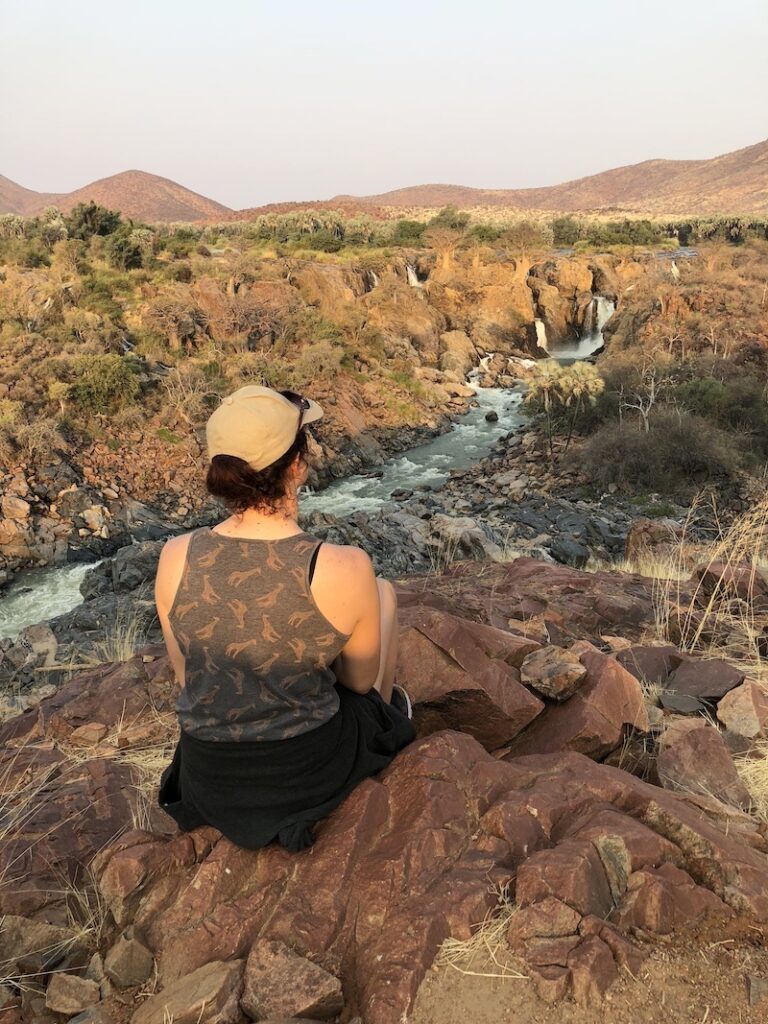
The Epupa Falls on the Kunene River
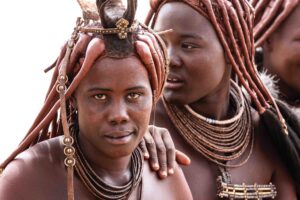 The Living Museum now allows visitors to discover the mysteries and wonders of Ovahimba culture. An exhilarating, energetic demonstration, the living museum gives you the opportunity to learn about the intriguing traditional life of the Himba people. This includes their dress, food and crafts (wood carving and metal work). Guests learn about how the homestead is built, with the Holy Fire at its heart, where all the important communication with the ancestors takes place. They also have the unique opportunity to sit in a hut with a bevy of Himba women learning about their intricate beauty rituals. The Ovahimba Living Museumopened officially in November 2016 and is the sixth of its kind. The museum can be found on the C43, 40 km north of Opuwo.
The Living Museum now allows visitors to discover the mysteries and wonders of Ovahimba culture. An exhilarating, energetic demonstration, the living museum gives you the opportunity to learn about the intriguing traditional life of the Himba people. This includes their dress, food and crafts (wood carving and metal work). Guests learn about how the homestead is built, with the Holy Fire at its heart, where all the important communication with the ancestors takes place. They also have the unique opportunity to sit in a hut with a bevy of Himba women learning about their intricate beauty rituals. The Ovahimba Living Museumopened officially in November 2016 and is the sixth of its kind. The museum can be found on the C43, 40 km north of Opuwo.
At 120 metres high and 700 metres wide, the Ruacana Falls on the Kunene River are one of the largest waterfalls in Africa. However, for most of the year the waterfall is dry, due to the Ruacana Hydropower Plant, which is the major source of electricity generated in Namibia.
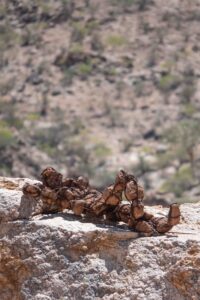 Kaokoland has long been described as a forelorn and mysterious place, often called the Wild West of Namibia. But, a new mystery has recently emerged, one that adds to the atmosphere of this fascinating desert wilderness: the Lone Men of Kaokoland. Nearly life-size rock sculptures of men have started appearing across the area three years ago. Made from the rock prevailing in the area, they blend in perfectly with their surroundings and take on different poses, catching you by surprise with their lifelike gait or posture. One figure sits on a hilltop, surveying the arid landscape, another one – referred to as the Dapper Stapper – strolls across the stony plains carrying a bundle on the end of a stick like an old-time traveller, another appears to be deep in thought, while yet another strides across the rugged land with a strong sense ofpurpose. Each figure has an aluminium disc attached to it, with a number and a message as to where it is going. The sculptures have been spotted along the road on the routes between Puros in the south, Van Zyl’s Pass in the east, Otjinungua in the north and the Skeleton Coast Park in the west.
Kaokoland has long been described as a forelorn and mysterious place, often called the Wild West of Namibia. But, a new mystery has recently emerged, one that adds to the atmosphere of this fascinating desert wilderness: the Lone Men of Kaokoland. Nearly life-size rock sculptures of men have started appearing across the area three years ago. Made from the rock prevailing in the area, they blend in perfectly with their surroundings and take on different poses, catching you by surprise with their lifelike gait or posture. One figure sits on a hilltop, surveying the arid landscape, another one – referred to as the Dapper Stapper – strolls across the stony plains carrying a bundle on the end of a stick like an old-time traveller, another appears to be deep in thought, while yet another strides across the rugged land with a strong sense ofpurpose. Each figure has an aluminium disc attached to it, with a number and a message as to where it is going. The sculptures have been spotted along the road on the routes between Puros in the south, Van Zyl’s Pass in the east, Otjinungua in the north and the Skeleton Coast Park in the west.
Accommodation
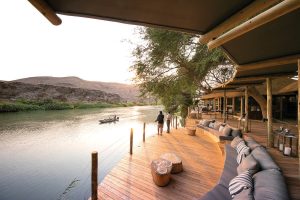
Wilderness Serra Cafema
Against the backdrop of the vast Hartmann’s Valley and its spectacular geology, gaze upon lush Kunene riverine vegetation. Put your feet up and immerse yourself in the spectacular surrounds. Relax, the powerful silence of the desert restoring your soul. Travel the dunes on foot and by quad-bike, or lean back in a boat and look
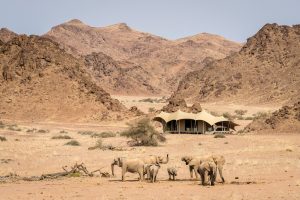
Wilderness Hoanib Skeleton Coast Camp
Remote Wilderness Hoanib Skeleton Coast Camp rests in Namibia’s famed, ancient Kaokoveld, in a life-filled private wilderness area near the legendary Skeleton Coast. Search the rust-coloured crags and arid plains for desert-adapted wildlife. Hike rocky outcrops, scramble down enormous sand dunes, marvel at desert oases, and dine under impossibly starry night skies. At Wilderness Hoanib
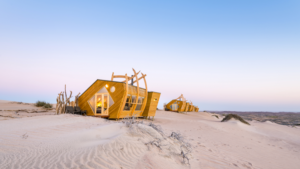
Shipwreck Lodge
Unravel the mystery
Shipwreck Lodge is located in the famous Skeleton Coast concession between the Hoarusib and Hoanib rivers in the Skeleton Coast National Park.
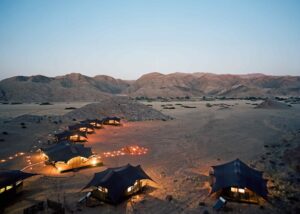
Hoanib Valley Camp
In a country jam-packed with vast, spectacularly beautiful landscapes, Kaokoland may just be the most incredible of them all. Deep in north-western Namibia, the area is a melee of towering mountains, sand dunes, and huge expanses of desert, scattered with unique wildlife and nomadic Himba settlements. It’s also one of Namibia’s most remote and wild

Epupa Falls Lodge
Epupa Falls Lodge & Campsite guards the Kunene River as it rushes downthecliffsoftheEpupaFalls.Here,onthedeck,amere100mabove the falls, many dry throats are rescued by a cold beer or icy water from the bar. Guests from the five Riverview Huts on stilts, three Ground level Budget chalets and the more private honeymoon chalet all enjoy dinner on the deck


